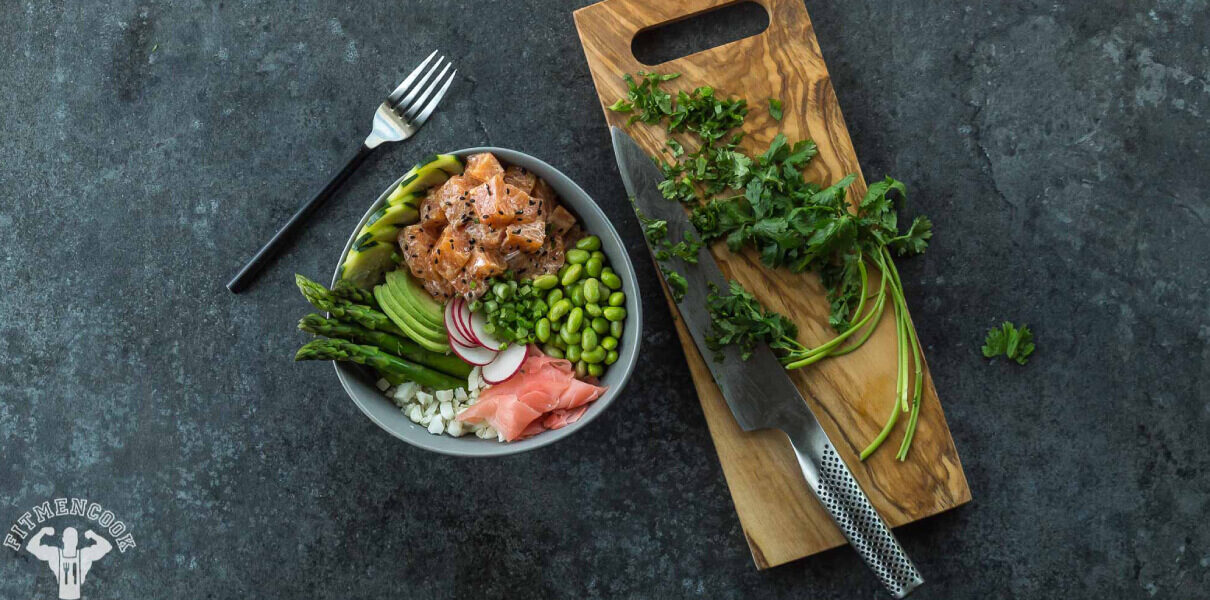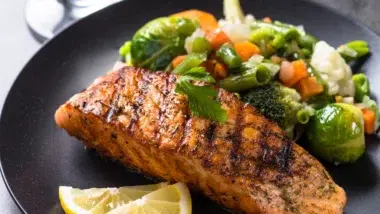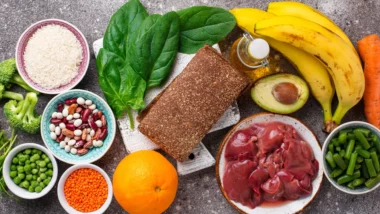A food that I’ve really come to love in recent years is poke. For me, it’s just like sushi but “spoken in my language” – a bowl. A random tidbit about me: I eat the majority of my meals standing up at the kitchen counter and like to eat out of bowl so I can mix everything together (unless it’s something crispy or sweet, then I strangely hate it when the food touches lol). Back to poke…
What I love about poke is that it is nutrient dense, full of lean protein, complex carbohydrates (depending on the rice you choose) and packed with healthy fats like omega-3 fatty acids. What I dislike most about it is the price. Usually it’s about $15 for a bowl that includes about 4oz of sushi grade fish that’s smothered in a fatty sauce. That’s quite pricey when you think about the cost of fish per pound. Almost every weekend I’d shovel out at least $15 – $20 to enjoy my favorite treat meal (that undoubtedly left me hungry in about 1 hour). It never occurred to me that I could make this at home for a fraction of the cost. In fact, when I did the math, it was over 50% cheaper AND even more nutrient dense because I could determine what went into it.
I don’t think anyone should be deprived the goodness that is poke, so here are my tips and tricks to creating an amazing poke abundance bowl.
BUY SUSHI GRADE FISH

This step always trips people up but it’s actually not as hard as it seems. Several grocery stores sell frozen sushi grade fish. This is NOT the same as buying tuna steak or raw salmon – you buy that and eat it raw and you could end up with a nasty stomach bug. Ask your grocer if they sell the individually wrapped sushi grade fish. If you purchase the frozen kind, know that you will likely not get to enjoy it that same day since it needs to defrost in your fridge overnight.
If they don’t sell frozen sushi, simply search “sushi grade fish market [your city]” on the Internet and you should be able to find sushi grade fish that restaurants purchase. You’ll be surprised at the price difference. For instance, a pound of wild caught sushi grade tuna is $27 – that’s the cost of one roll that would include 8oz of tuna in some restaurants. Salmon is usually cheaper than tuna so purchase what your budget allows, just make sure it is sushi grade.
As a last resort, and this option is more expensive, if your grocery store makes sushi rolls, you can ask the sushi chef on site to sell you just the sushi (sashimi) at a reduced cost. I’ve done this several times but really, it is a hit or miss.
CUT/DICE/CHOP THE FISH
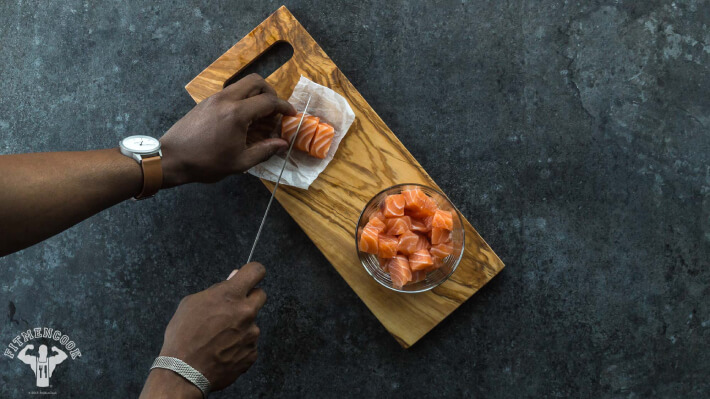
Get the sharpest knife in your kitchen and cut the sushi meat into small chunks. It’s important the knife is sharp so you don’t tear the flesh, rather you slice it neatly into cubes. I like mine slightly bigger than most, about 1/2-inch thick, but feel free to trim these down even more.
MAKE A SAUCE
Besides the fish, the sauce is probably the most important part of the poke bowl because it gives the dish a personality and brings the flavors together. Here are my guidelines for making a sauce:
- Use an aromatic ingredient such as sesame oil – you don’t need too much of this. Just enough to “taste” or give an essence to the meal. If you cannot afford sesame oil, try peanut oil. Remember, you don’t need to add a lot of this – 1 or 2 teaspoons per serving.
- Make it creamy – use ripe avocado or a reduced calorie mayo to “coat” the fish. These will likely increase the calories and heartiness of the dish, so choose purposeful, heart-healthy ingredients whenever possible. For example, I use an olive oil based mayo or safflower mayo instead of traditional mayo.
- Spice it up – add a little bit of heat to taste. You don’t need this is to be SUPER hot, but just enough to give some kick. Part of enjoying poke is the flavor journey you experience – the spicy flavors are offset by the creaminess, and your mouth is cooled by the chilled fish (and other ingredients). Examples include Sriracha, red chili garlic sauce, wasabi paste, horseradish or even chili or habanero sauce (for a Latin inspired treat).
- Add soy flavor – depending on which condiments you use, you need to be judicious about adding soy flavor to the sauce because you don’t want it to be so salty that it’s not enjoyable. I’ll add a splash of low sodium soy, tamari, coconut aminos or Bragg liquid aminos. If you find that your sauce is too salty, simply add 1/2 teaspoons of rice vinegar (or water) until you reach the desired salt level.
- Add some zest and fragrance – similar to the aromatic ingredient but not as strict so you can add a bit more here to taste. Plus, these additions generally don’t impact overall calories. Examples: lime or lemon zest, lime or lemon juice, garlic, ginger, green onions or fish sauce (be careful with this one if you’ve never tried it).
Here’s one of my go-to sauces for 1lb of fish:
- 2 or 3 tablespoons lite safflower mayo
- Sriracha (or red chili garlic sauce) to taste
- 2 teaspoons minced garlic
- 1 teaspoon low-sodium tamari (or soy)
- lime zest to taste
Or, try this sauce from these poke nachos.
Once you make the sauce, gently fold the fish in the sauce and allow the flavors to meld for about 20 minutes in the fridge in a covered bowl.

Add some sesame seeds for garnish (and crunch) before serving it.
CHOOSE YOUR “RICE”
Poke is often enjoyed with white or jasmine rice but feel free to enjoy it with whatever compliments your diet at the moment. Here are some complex carbohydrates you can try it with:
- short-grain (or long grain) brown rice
- brown jasmine rice
- quinoa
- chilled boiled sweet potato, chopped into small pieces.
Here are some low-carb suggestions:
- cauliflower rice or pearls (shown here)
- Shirataki noodles (or rice)
- finely shredded cabbage
USE FRESH VEGETABLES – TRY FOR 3 DIFFERENT COLORS
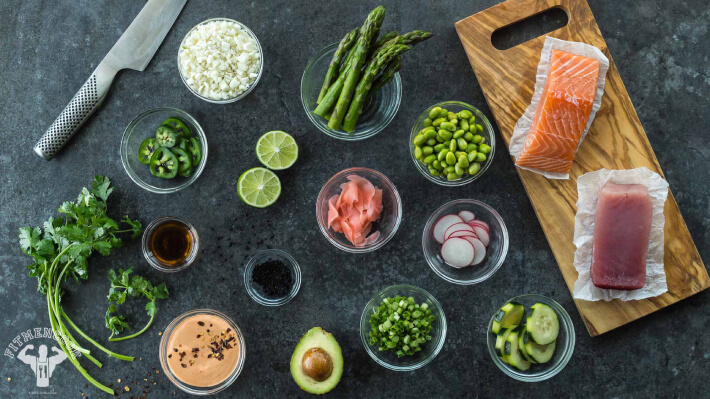
Making an abundance bowl is not (solely) about making the bowl as calorie-dense as possible; rather, it’s about loading up on the nutrients as well. Make sure your bowl has at least 3 different colors and add ingredients that boost/manipulate the macronutrient profile so it’s the “right amount” for your goals. For instance, I try to boost the protein in my bowls by adding shelled edamame. It may go without saying but I recommend adding chilled vegetables to the final bowl so not to “cook” the fish with the steam of the food.
Here’s what I used for this bowl:
- steamed, then chilled, cauliflower pearls so it is crisp-tender
- steamed, then chilled, asparagus
- edamame
- radish
- green onion
- cucumber
- cilantro
- avocado
- jalapeno
- picked ginger
- lime
You can add fruit. I find that tropical fruits are best and you should incorporate the fruits in the sauce for a more enhanced flavor experience. Best fresh fruits: pineapple, mango, papaya, jicama and dragonfruit.
